Every Touchpoint Counts: New Research on Customer Journey Management for Healthcare
Every Touchpoint Counts: New Research on Customer Journey Management for Healthcare
Healthcare patients are changing the way they pick providers for themselves and their loved ones. Now, to reach every generation of patients and patient advocates, providers must have a strong digital presence at every touchpoint in the customer journey.
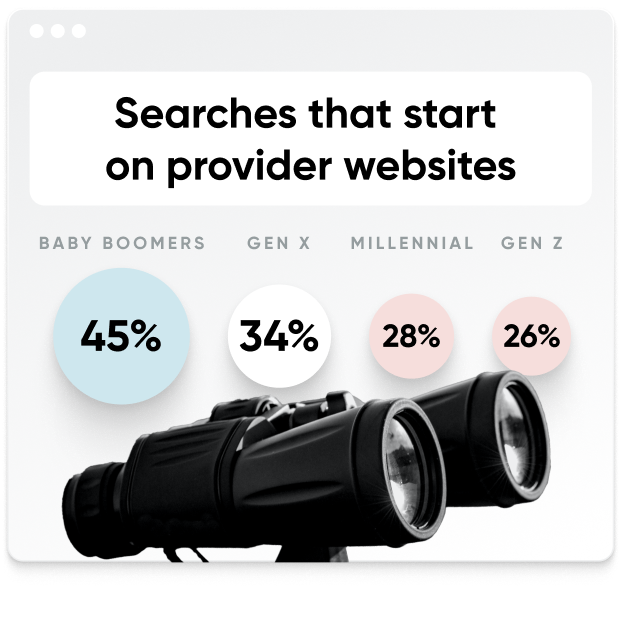
The healthcare marketing landscape is changing quickly.
By 2030:
- All Baby Boomers will be over the age of 65,
- The eldest Gen Xers will be nearing retirement age, and
- Adult children and grandchildren from Gen X, Y, and Z will be increasingly involved in making healthcare decisions with their elders (while managing their own healthcare journeys).*
Meanwhile, there's been a cultural shift in beliefs about healthcare. For Gen Z and Millennials, self-care is healthcare. These patients aren't waiting for a health-related event to spark their provider search. In fact, 52% of Generation Z report they are looking for healthcare providers each month.
As providers strive to improve the patient experience without stretching budgets and staff too thin, it's become increasingly difficult to scalably deliver personalized outreach to patients on their preferred channels. It's also challenging to demonstrate the ROI for digital marketing efforts when healthcare, patient expectations, and the digital landscape are changing - an issue further complicated by stringent privacy laws.
Patients and their healthcare advocates are using more digital channels than ever to find provider information and healthcare advice. From optimizing provider visibility to generating more new appointments, here's what healthcare marketers need to know about reaching and engaging patients.
Awareness
 Most patients no longer turn to a provider's website first. Only 45% of Baby Boomers visit a provider's website as the first step in their search journey. Those numbers drop significantly for each younger generation. Here's what the research says:
Most patients no longer turn to a provider's website first. Only 45% of Baby Boomers visit a provider's website as the first step in their search journey. Those numbers drop significantly for each younger generation. Here's what the research says:
- 34% of Gen X starts their customer journey on a healthcare provider's website
- 28% of Millennials start their customer journey on a healthcare provider's website
- 26% of Gen Z starts their customer journey on a healthcare provider's website
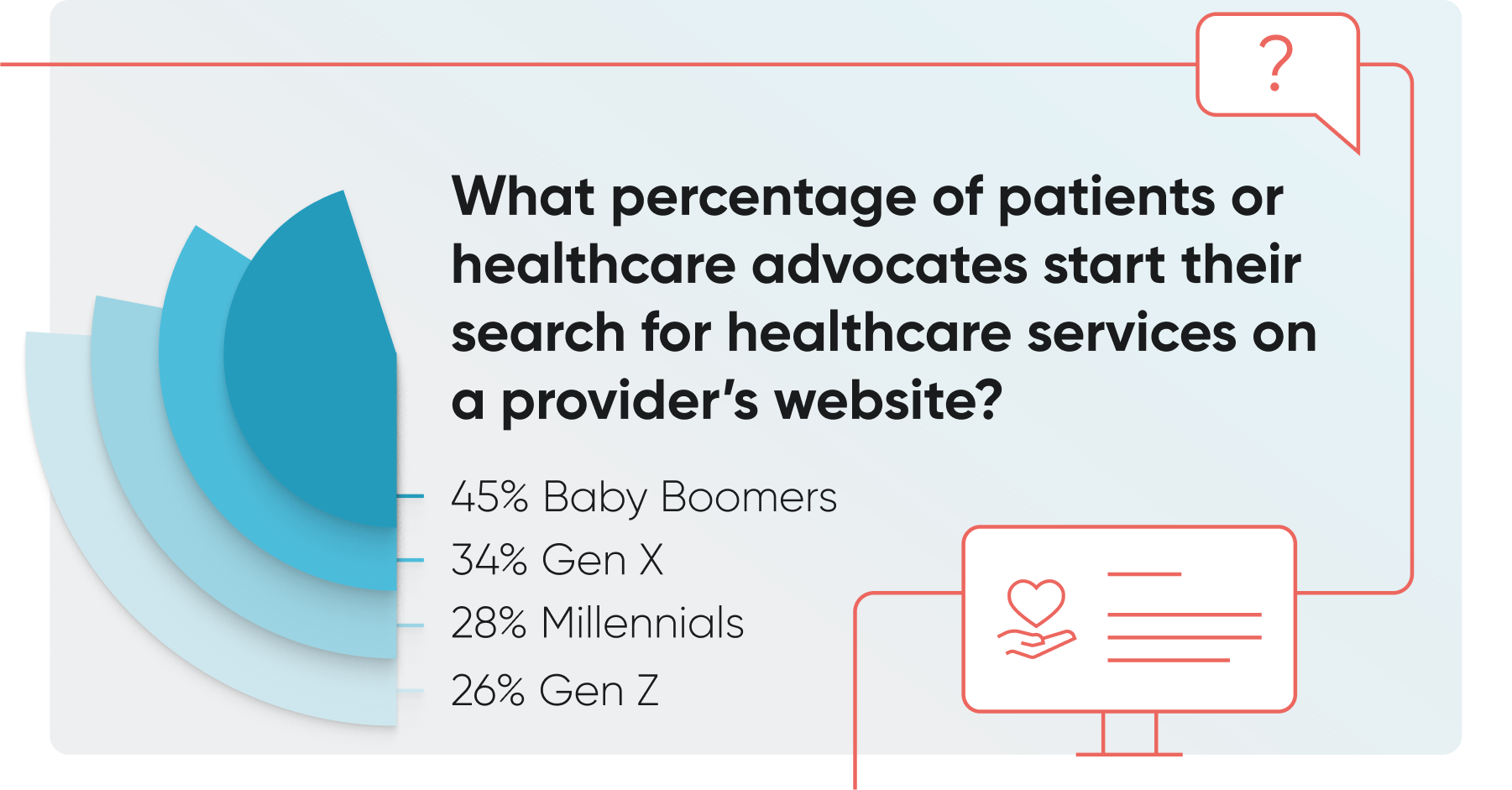 Patients and patient advocates in every generation start their journey by researching providers and specialties across many types of online channels. Search engines are the most popular channel for Gen X, Y, and Z, but they make up less than half of all journey starting points. Here's how people are using traditional search engines to find healthcare brands and providers:
Patients and patient advocates in every generation start their journey by researching providers and specialties across many types of online channels. Search engines are the most popular channel for Gen X, Y, and Z, but they make up less than half of all journey starting points. Here's how people are using traditional search engines to find healthcare brands and providers:
- 37% of Baby Boomers use search engines as the first touchpoint in the customer journey
- 47% of Gen X use search engines as the first touchpoint in the customer journey
- 43% of Millennials use search engines as the first touchpoint in the customer journey
- 40% of Gen Z use search engines as the first touchpoint in the customer journey
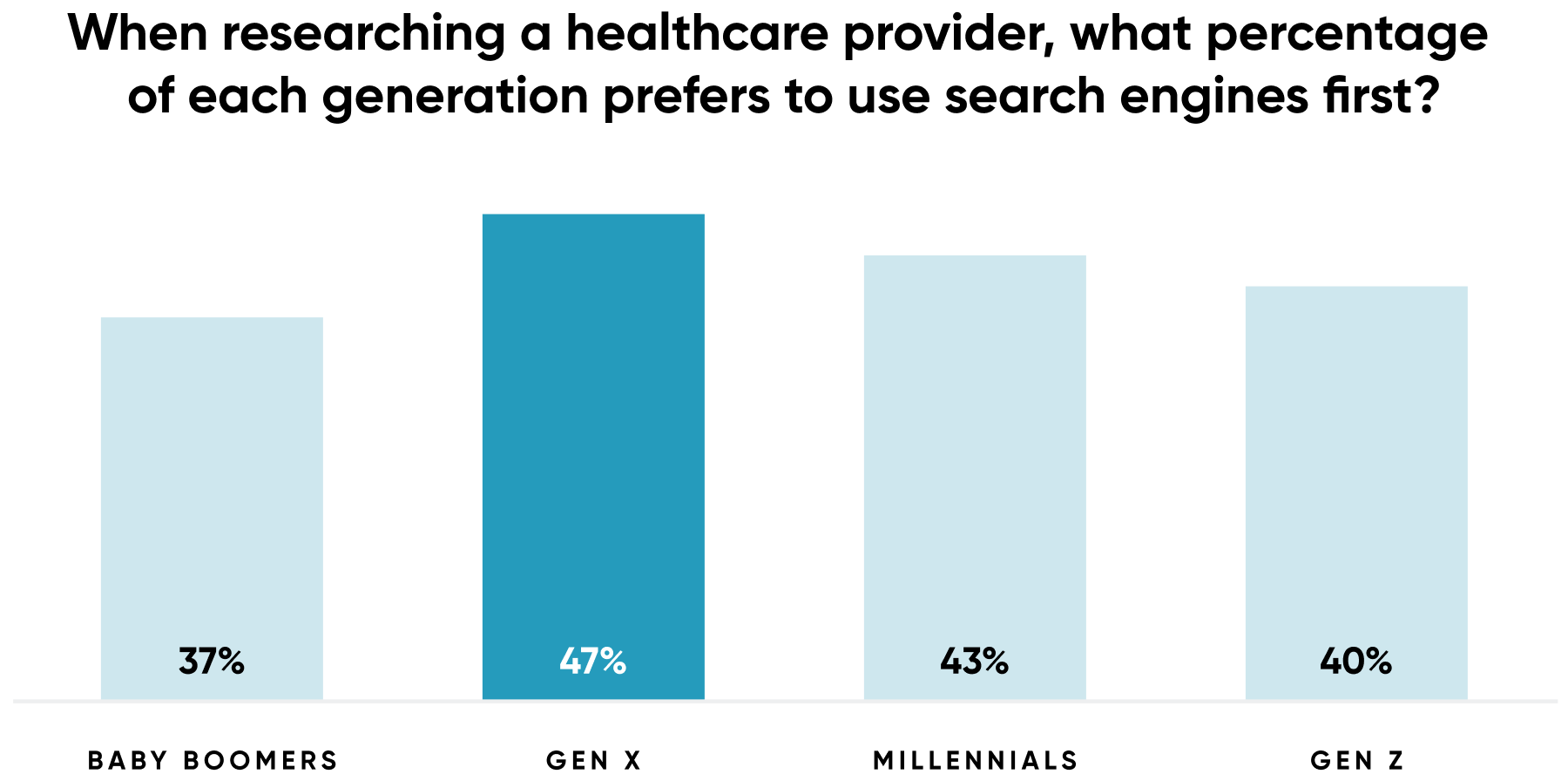 While social has never been synonymous with healthcare, trendlines suggest that may be changing. 88% of people say they use social media platforms to find more information about a brand. Providers looking for an edge in attracting new, ideal patients can no longer afford to ignore social media platforms. For example, plastic surgeons have become increasingly active on TikTok to promote their work and reach new patients. Here's how each generation compares to Baby Boomers when it comes to starting their search for healthcare providers on social media:
While social has never been synonymous with healthcare, trendlines suggest that may be changing. 88% of people say they use social media platforms to find more information about a brand. Providers looking for an edge in attracting new, ideal patients can no longer afford to ignore social media platforms. For example, plastic surgeons have become increasingly active on TikTok to promote their work and reach new patients. Here's how each generation compares to Baby Boomers when it comes to starting their search for healthcare providers on social media:
- 1.5x as many Gen X patients start searching for healthcare providers on social media
- 2x as many Millennials start searching for healthcare providers on social media
- 4x as many Gen Z patients start searching for healthcare providers on social media
Maps are emerging as a starting point in the search for healthcare providers. Gen X, Millennials, and Gen Z all appear to weigh the convenience of a provider's location and hours as a factor in their discovery. Here's how each generation compares to Baby Boomers when using maps as the starting point for a healthcare provider:
- 3x as many Gen Xers start their search with maps
- 6x as many Millennials start their search with maps
- 6x as many Zoomers start their search with maps
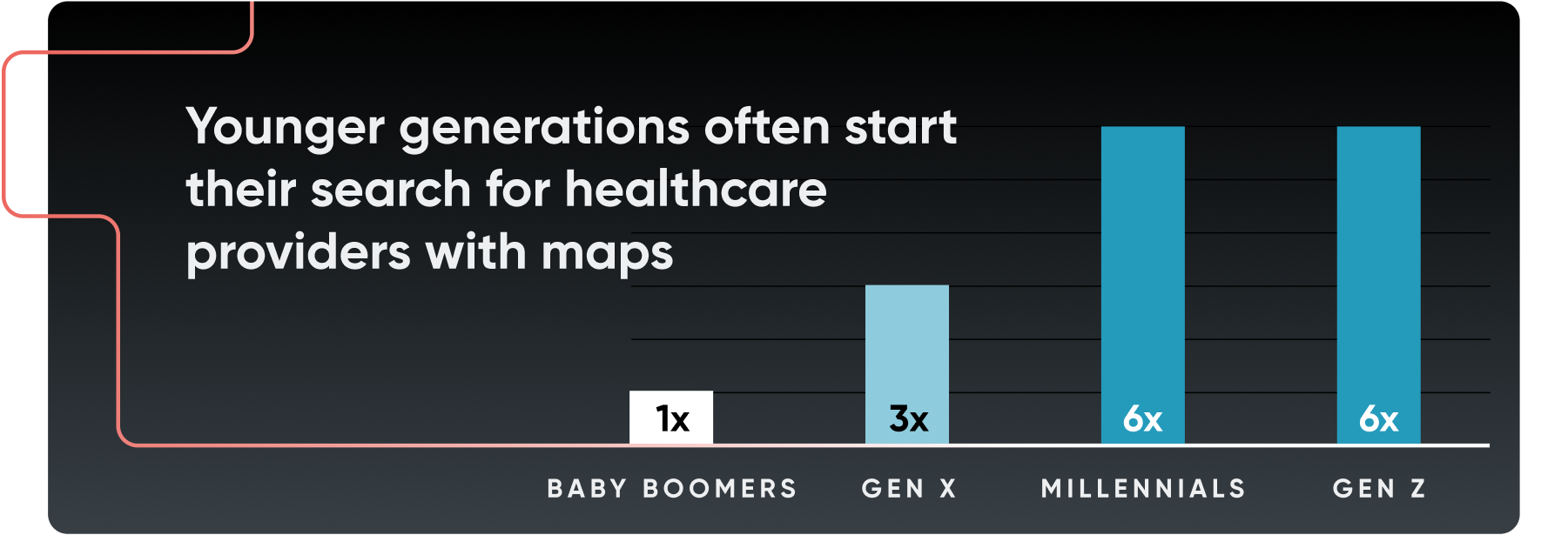
Consideration
 Online reviews impact the customer decision-making in healthcare more than in any other industry. 74% of patients and patient advocates say patient reviews are the top factor in choosing a healthcare provider. Significantly, 60% of patients are likely to choose a physician based on the provider's engagement and responsiveness to patient reviews. The research shows they're also important across demographics:
Online reviews impact the customer decision-making in healthcare more than in any other industry. 74% of patients and patient advocates say patient reviews are the top factor in choosing a healthcare provider. Significantly, 60% of patients are likely to choose a physician based on the provider's engagement and responsiveness to patient reviews. The research shows they're also important across demographics:
- 55% of Baby Boomers consider online reviews when selecting a healthcare provider
- 59% of Gen X considers online reviews when selecting a healthcare provider
- 73% of Millennials consider online reviews when selecting a healthcare provider
- 73% of Gen Z consider online reviews when selecting a healthcare provider
 But seeing reviews, even good ones, isn't enough. If healthcare marketers don't have a strategy for responding to reviews quickly --- and at scale --- they'll struggle to win (and retain) patients of all ages. New and existing patients want to see review engagement, and they expect quick responses:
But seeing reviews, even good ones, isn't enough. If healthcare marketers don't have a strategy for responding to reviews quickly --- and at scale --- they'll struggle to win (and retain) patients of all ages. New and existing patients want to see review engagement, and they expect quick responses:
- 51% of Baby Boomers expect a response to patient reviews within one week
- 64% of Gen X expects a response to reviews within one week
- 71% of Millennials expect a response to reviews within one week
- 69% of Gen Z expects a provider to respond to reviews within one week
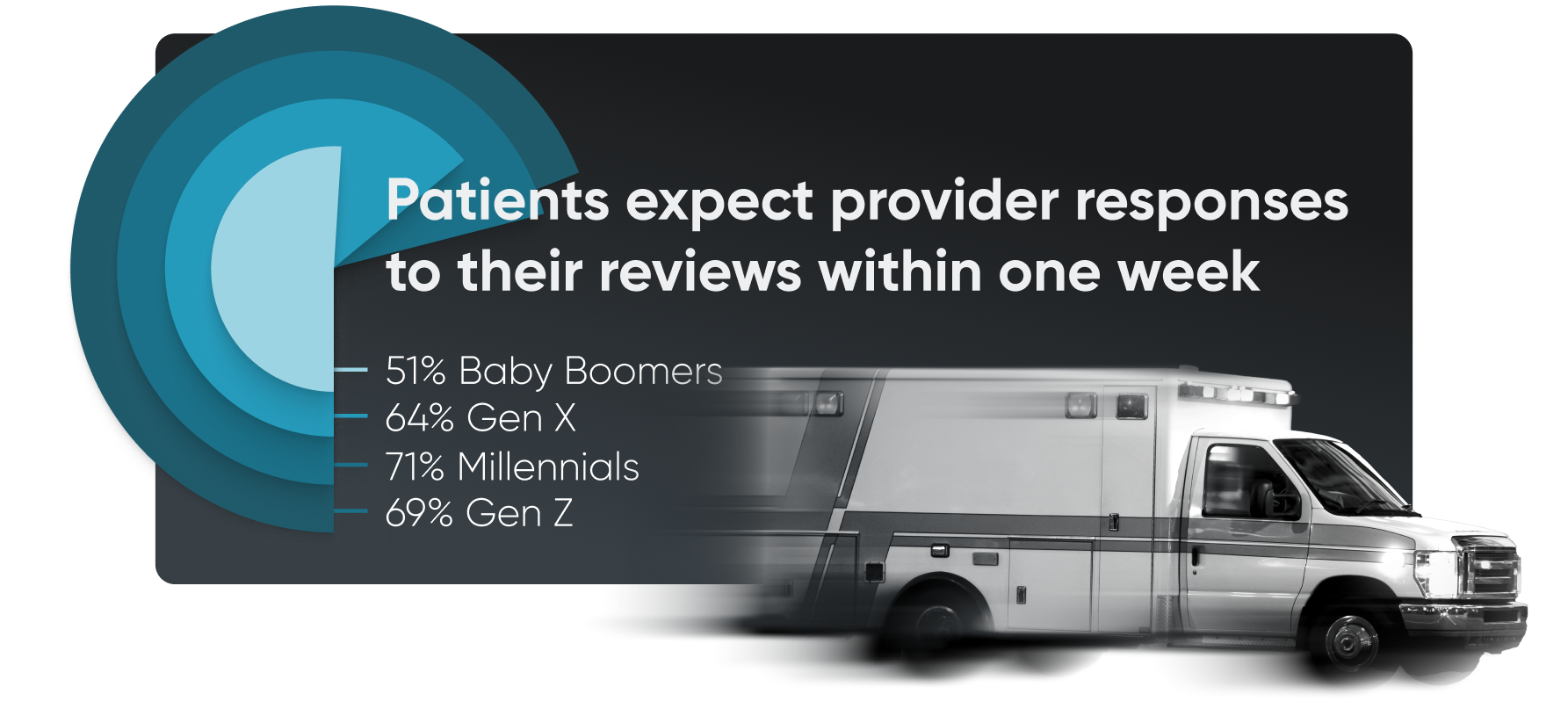
Decision and Loyalty
 Patients prefer to schedule services when the provider's digital presence is up-to-date with accurate information. A digital presence that's up-to-date is key, too. 85% of patients say it's very important to them that a healthcare provider's information is correct when deciding whether or not to schedule an appointment.
Patients prefer to schedule services when the provider's digital presence is up-to-date with accurate information. A digital presence that's up-to-date is key, too. 85% of patients say it's very important to them that a healthcare provider's information is correct when deciding whether or not to schedule an appointment.
 Correct, multi-channel information wins patients over; incorrect and missing information blocks trust. It likely deters loyalty, too. How so? Every generation feels frustrated when they can't find the information they're looking for --- or they discover it's inaccurate.
Correct, multi-channel information wins patients over; incorrect and missing information blocks trust. It likely deters loyalty, too. How so? Every generation feels frustrated when they can't find the information they're looking for --- or they discover it's inaccurate.
- When scheduling an appointment, 1 out of 2 patients says they look for a different healthcare provider if they come across incorrect or missing information
- 1 out of 2 patients reports a lack of reviews makes it challenging to earn their trust enough to book an appointment
- 2 out of 5 patients report that outdated or conflicting information is a common problem for them as they search, consider, and select providers online
When it comes to building trust and ensuring loyalty, each generation is influenced by different types of content posted across each channel. Take a look:
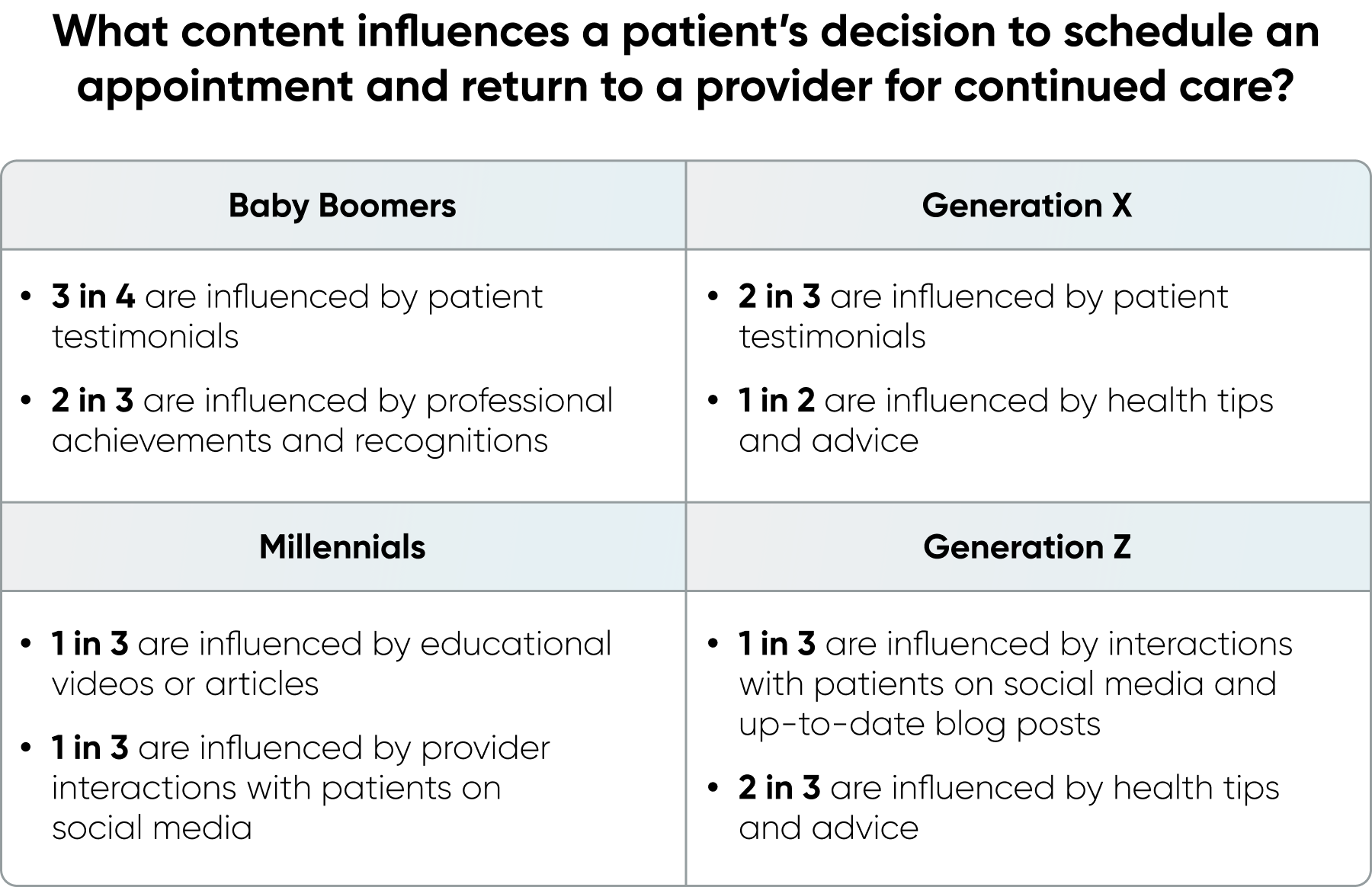
Healthcare customers are turning to multiple (and new) touchpoints on their journey to find care
As Gen Xers, Millennials, and the eldest members of Gen Z grow into their personal healthcare needs, they're also becoming caregivers and healthcare advocates for their elders. While they search for providers who can help them, they choose to schedule with providers who've earned their trust.
Yet, because every generation is constructing its own, unique customer journey with different touchpoints, providers must meet them on multiple channels, including reviews, social, maps, websites, and search. Accurately. Consistently. Cost-effectively and at scale. It's key to closing the gap between patient expectations and provider growth.
Study Details: The results are from an online survey of 1,051 U.S.-based adults aged 18 and up. Survey participants looked online for a healthcare provider in the past year. The survey was conducted from June 27, 2024 to July 10, 2024 by Researchscape on behalf of Yext. Results were weighted to the U.S. population by 10 demographic questions (country, state, census area, marital status, generation, education level, ethnicity, household income, and employment status).



